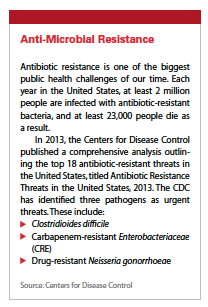Plants as Anti-infectives
Alexander Huang, President and Chairman of Quellthera, talks about the company’s research on biomimicry of plant immune processes as potential therapeutics for hard-to-treat infections.
 Infections caused by antibiotic-resistant germs are difficult, and may soon become impossible, to treat. In most cases, antibiotic-resistant infections require extended hospital stays, additional follow-up doctor visits, and costly and toxic alternatives.
Infections caused by antibiotic-resistant germs are difficult, and may soon become impossible, to treat. In most cases, antibiotic-resistant infections require extended hospital stays, additional follow-up doctor visits, and costly and toxic alternatives.
Quellthera is developing anti-pathogenic therapies that are modeled after the plant kingdom’s strategies for controlling bacterial behavior. By suppressing bacterial virulence while reducing host vulnerability, the company hopes to give physicians new therapies and preventive measures that circumvent antibiotic resistance.
The company’s research takes a look at polyphenols, which are the most abundant class of plant compounds common in many plant-based foods and beverages. The absorption and metabolism of these compounds have been well-described and are attributed to a number of passive health benefits, but Quellthera believes they have unlocked the true potential of polyphenols as modern pharmaceuticals.
“We mimicked how a transient biologic reaction at the core of plant immunity creates an entirely new class of human therapeutics," says Alexander Huang, CEO and founder of Quellthera. “Plant epidermal cells, including the leaves, fruits, and roots, perform similar protective functions as our skin and the lining of our digestive tract. The plant kingdom evolved a localized but broad-spectrum, first-line defense against microbial threats plant known in botany as hypersensitive response, the rapid response of plant surface cells to foreign proteins, such as the toxins of potentially damaging pathogens."
Mr. Huang says when attacked, plant cells immediately surrounding the threat go into programmed apoptosis. “This is a self-destruct that causes a break down of internal cell  structures, mixing normally compartmentalized polyphenols and oxidative compounds with peroxidase enzymes," he says. “This creates a rapid chemical conversion of polyphenols into reactive intermediates called quinones or in our case polyquinones, which aggressively bind to, and disable, a wide range of protein and peptides involved in bacterial communications, colonization, toxin attack and other extracellular interactions essential to damaging behaviors against the host. “
structures, mixing normally compartmentalized polyphenols and oxidative compounds with peroxidase enzymes," he says. “This creates a rapid chemical conversion of polyphenols into reactive intermediates called quinones or in our case polyquinones, which aggressively bind to, and disable, a wide range of protein and peptides involved in bacterial communications, colonization, toxin attack and other extracellular interactions essential to damaging behaviors against the host. “
Mr. Huang says the localized nature of hypersensitive response stops infection immediately while preventing collateral damage to the plant’s microbiome.
Quellthera’s lead investigational drug, EpiQuell, is expected to enter Phase II trials this year to treat Clostridium difficile infection.
“We have been able create a novel, oral liquid prodrug that is virtually non-toxic to healthy tissue, but forms polyquinones at sites of compromised gut lining, to both restore epithelial barrier integrity and stop pathogen attack without microbiome disruption or promoting cross resistance with antibiotics," Mr. Huang says. “The key is target-activation by accumulation of human and bacterial peroxidase enzymes characteristic of infected and inflamed gut tissue."
Quellthera continues to explore mechanisms of action and new applications, but the company has already demonstrated safety with potent anti-diarrheal and anti-inflammatory effects in multiple animal and human trials. The company developed a product under supplement regulations specifically to generate IND-enabing studies on a range of GI functional disorders and infections. Mr. Huang says EpiQuell has shown great promise as a sustainable alternative to oral and topical antibiotics for combating a broad spectrum of non-bloodborne infections that represent the majority use of acute anti-infective therapies worldwide.
Clostridium difficile is the first of Quellthera’s target indications. It is a Gram-positive anaerobic bacterium that causes severe diarrhea and colitis. It is the leading cause of healthcare-associated infection in the United States affecting 500,000 Americans each year. It’s considered one of the top three most urgent infection priorities of the CDC and WHO.
“The C. difficile indication will showcase EpiQuell’s unique ability to address an antibiotic-resistant infection and the inflammatory damage it does to the colon," Mr. Huang says. “Traditional antibiotics can cause indiscriminate collateral damage to the microbiome making patients more susceptible to opportunistic pathogens like C. difficile. EpiQuell is a completely novel drug paradigm that shares nothing in common with antibiotics, and we intend it as an effective treatment option that could lower C. diff recurrence and enable practical prophylaxis in hospitals."
He says the company has identified high incidence clinical sites that will enable rapid enrollment, with anticipated filing of an NDA within three years. Quellthera will leverage the IND-enabling safety and human clinical studies already completed by Quellthera’s parent company, LiveLeaf.
Quellthera will use new FDA regulations for botanical drug guidelines that were put into effect in 2017. Previously, botanical plant-based drugs were treated much the same as any other drug. Companies developing therapies from plants had to be able to identify the specific therapeutic contribution of every component.
Quellthera expects to expand EpiQuell indications to a number of common causes of GI infection and common functional gastric disorders such as IBS.
The company is also developing DermaQuell topical platform, which will initially target methicillin resistant Staphylococcus Aureus (MRSA) infection; if approved this would be a first topical indication into wound applications. (PV)
~~~~~~~~~~~~~~~~~~~~~~~~~
Anti-Microbial Resistance
Antibiotic resistance is one of the biggest public health challenges of our time. Each year in the United States, at least 2 million people are infected with antibiotic-resistant bacteria, and at least 23,000 people die as a result.
In 2013, the Centers for Disease Control published a comprehensive analysis outlining the top 18 antibiotic-resistant threats in the United States, titled Antibiotic Resistance Threats in the United States, 2013. The CDC has identified three pathogens as urgent threats. These include:
Clostridioides difficile
Carbapenem-resistant Enterobacteriaceae (CRE)
Drug-resistant Neisseria gonorrhoeae
Source: Centers for Disease Control

















